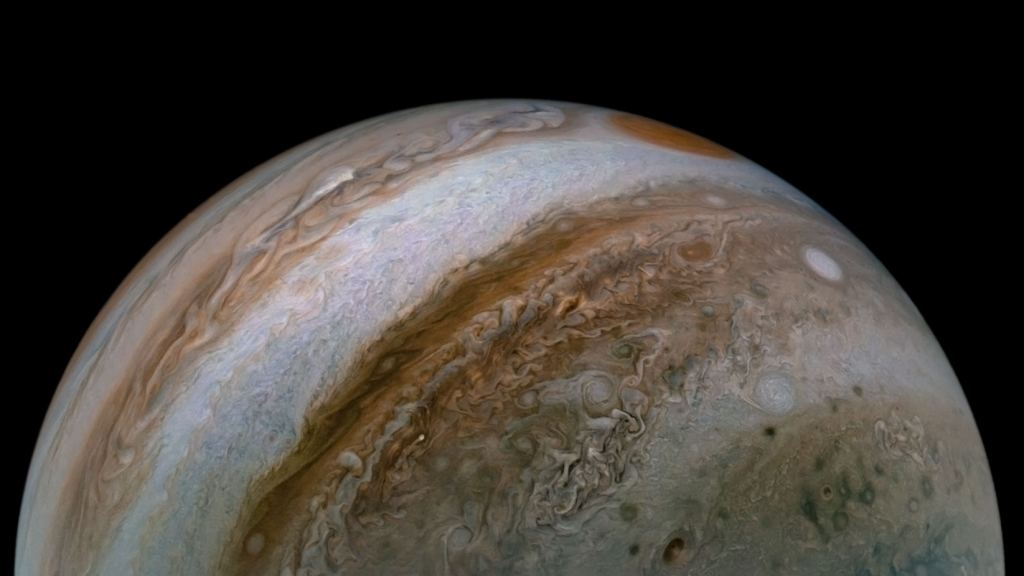Jupiter is composed almost entirely of hydrogen and helium. The amounts of each closely conform to the theoretical quantities in the primordial solar nebula. But it also contains other heavier elements, which astronomers call metals.
Even though metals are a small component of Jupiter, their presence and distribution tell astronomers a lot. According to a new study, Jupiter’s metal content and distribution mean that the planet ate a lot of rocky planetesimals in its youth. Ever since NASA’s Juno spacecraft reached Jupiter in July 2016 and started gathering detailed data, it’s been transforming our understanding of Jupiter’s formation and evolution.
One of the mission’s features is the Gravity Science instrument. It sends radio signals back and forth between Juno and the Deep Space Network on Earth. The process measures Jupiter’s gravitational field and tells researchers more about the planet’s composition.
Remove All Ads on Universe Today Join our Patreon for as little as $3! Get the ad-free experience for life When Jupiter formed, it began by accreting rocky material. A period of rapid gas accretion from the solar nebula followed that, and after many millions of years, Jupiter became the behemoth it is today. But there’s a significant question regarding the initial period of rocky accretion.
Did it accrete larger masses of rocks like planetesimals? Or did it accrete pebble-sized material? Depending on the answer, Jupiter formed on different time scales. A new study set out to answer that question. It’s titled “Jupiter’s inhomogeneous envelope ,” and it’s published in the journal Astronomy and Astrophysics.
The lead author is Yamila Miguel, an Assistant Professor of Astrophysics at the Leiden Observatory & The Netherlands Institute for Space Research. We’re growing accustomed to gorgeous images of Jupiter thanks to the Juno spacecraft’s JunoCam . But what we see is only skin deep.
All those spellbinding images of the clouds and storms are only the thin 50 km (31 miles) outermost layer of the planet’s atmosphere. The key to Jupiter’s formation and evolution is deeply buried in the planet’s atmosphere, which is tens of thousands of kilometres deep. It’s widely accepted that Jupiter is the oldest planet in the Solar System.
But scientists want to know how long it took to form. The paper’s authors wanted to probe the metals in the planet’s atmosphere using Juno’s Gravity Science experiment. The presence and distribution of pebbles in the planet’s atmosphere play a central role in understanding Jupiter’s formation, and the Gravity Science experiment measured pebble dispersion throughout the atmosphere.
Before Juno and its Gravity Science experiment, there was no precise data on Jupiter’s gravity harmonics. The researchers found that Jupiter’s atmosphere isn’t as homogenous as previously thought. More metals are near the planet’s center than in the other layers.
Altogether, the metals add up to between 11 and 30 Earth masses. With data in hand, the team constructed models of Jupiter’s internal dynamics. “In this paper, we assemble the most comprehensive and diverse collection of Jupiter interior models to date and use it to study the distribution of heavy elements in the planet’s envelope,” they write.
The team created two sets of models. The first set is 3-layer models and the second is dilute core models. “There are two mechanisms for a gas giant like Jupiter to acquire metals during its formation: through the accretion of small pebbles or larger planetesimals,” said lead author Miguel.
“We know that once a baby planet is big enough, it starts pushing out pebbles. The richness of metals inside Jupiter that we see now is impossible to achieve before that. So we can exclude the scenario with only pebbles as solids during Jupiter’s formation.
Planetesimals are too big to be blocked, so they must have played a role. ” The abundance of metals in Jupiter’s interior decreases with distance from the center. That signifies a lack of convection in the planet’s deep atmosphere, which scientists thought was present.
“Earlier, we thought that Jupiter has convection, like boiling water, making it completely mixed,” said Miguel. “But our finding shows differently. ” “We robustly demonstrate that the heavy element abundance is not homogeneous in Jupiter’s envelope,” the authors write in their paper.
“Our results imply that Jupiter continued to accrete heavy elements in large amounts while its hydrogen-helium envelope was growing, contrary to predictions based on the pebble-isolation mass in its simplest incarnation, favouring instead planetesimal-based or more complex hybrid models. ” The authors also conclude that Jupiter didn’t mix by convection after it formed, even when it was still young and hot. The team’s results also extend to the study of gaseous exoplanets and efforts to determine their metallicity.
“Our result … provides a base example for exoplanets: a non-homogeneous envelope implies that the metallicity observed is a lower limit to the planet bulk metallicity. ” In Jupiter’s case, there was no way of determining its metallicity from a distance. Only when Juno arrived could scientists measure the metallicity indirectly.
“Therefore, metallicities inferred from remote atmospheric observations in exoplanets might not represent the bulk metallicity of the planet. ” When the James Webb Space Telescope starts science operations, one of its tasks is measuring exoplanet atmospheres and determine their composition. As this work shows, the data Webb provides may not capture what’s happening in the deeper layers of giant gas planets.
.
From: universetoday
URL: https://www.universetoday.com/156235/jupiter-is-up-to-9-rock-and-metal-which-means-it-ate-a-lot-of-planets-in-its-youth/



